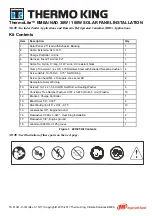
Technical data
Panel PC 2100 user's manual V1.17
147
2.3.4 CFast cards
2.3.4.1 General information
CFast cards are easily exchangeable data storage devices. Due to their robustness against environmental influ-
ences (temperature, shock, vibration, etc.), CFast cards are ideal for use as storage media in industrial environ-
ments.
CFast cards are a variant of CompactFlash that use the SATA protocol instead. CFast cards are not compatible
with CompactFlash cards.
2.3.4.2 Basic information
CFast cards used in industrial automation must be extremely reliable. To achieve this, the following points are very
important:
•
The flash technology used
•
An efficient algorithm for maximizing service life
•
Good mechanisms for detecting and correcting errors in the flash memory
2.3.4.2.1 Flash technology
CFast cards are currently available with MLC (multi-level cell) and SLC (single-level cell) flash blocks.
In addition to a service life that is 10 times longer than MLC flash blocks, SLC flash blocks also have write/erase
cycles that are 33 times faster, making CFast cards with SLC flash blocks the preferred choice for industrial envi-
ronments. These factors are heavily dependent on the actual application, however, so no blanket statement can
be made.
Due to increasing cost pressure as well as improved wear level algorithms and monitoring features (S.M.A.R.T.),
MLC flash technology is still also widely used in this market.
2.3.4.2.2 Wear leveling
Wear leveling refers to an algorithm that can be used to maximize the service life of a CFast card. Different algo-
rithms are possible:
•
Dynamic wear leveling
•
Static wear leveling
The basic idea behind wear leveling is that data is distributed over a broad range of blocks or cells on the data
storage device so that the same areas are not erased and rewritten over and over again.
2.3.4.2.2.1 Dynamic wear leveling
Dynamic wear leveling makes it possible to utilize unused flash blocks when writing to a file.
If 80% of the data storage device is already taken up by files, then only 20% can be used for wear leveling.
The service life of the CFast card therefore depends on the unused flash blocks.
2.3.4.2.2.2 Static wear leveling
Static wear leveling additionally monitors which data is only seldom modified. From time to time, the controller
moves this data to blocks that have already been written to frequently in order to prevent further wear on those cells.
2.3.4.2.3 ECC error correction
Bit errors can result from the inactivity or operation of a certain cell. Error-correcting code (ECC) added by the
hardware or software can detect and correct many errors of this type.
2.3.4.2.4 S.M.A.R.T. support
Self-Monitoring, Analysis and Reporting Technology (S.M.A.R.T.) is an industry standard for mass storage devices
that was introduced to monitor important parameters and detect imminent failures. Critical performance and cali-
bration data is monitored and stored in an effort to predict the probability of error states.
















































